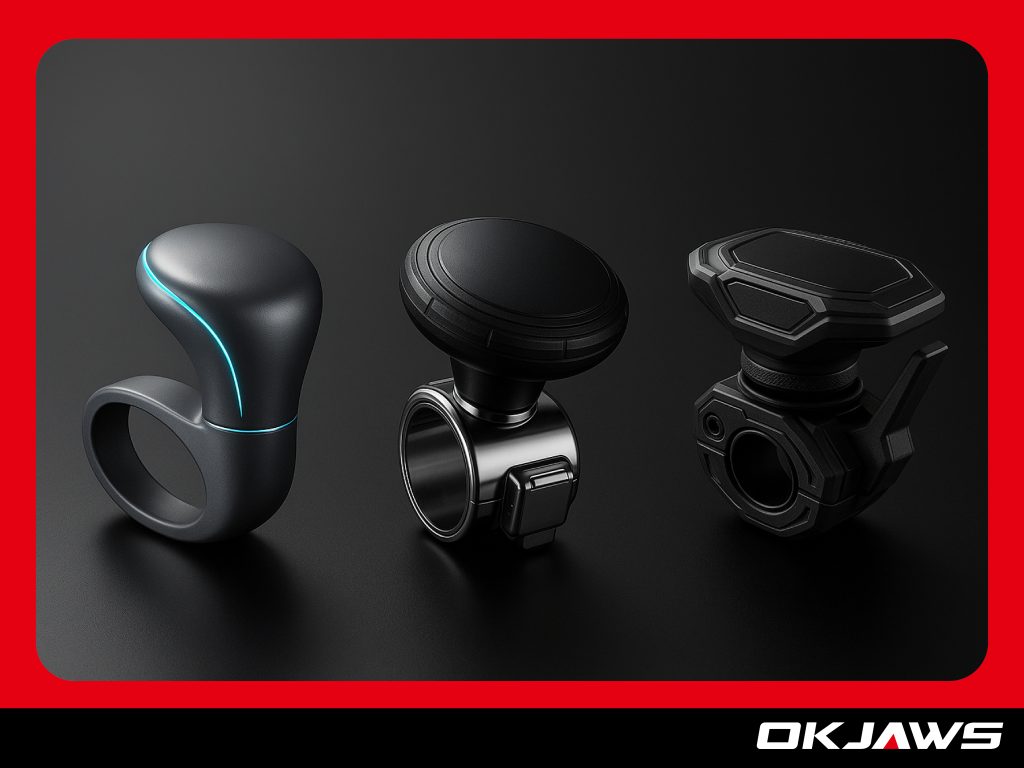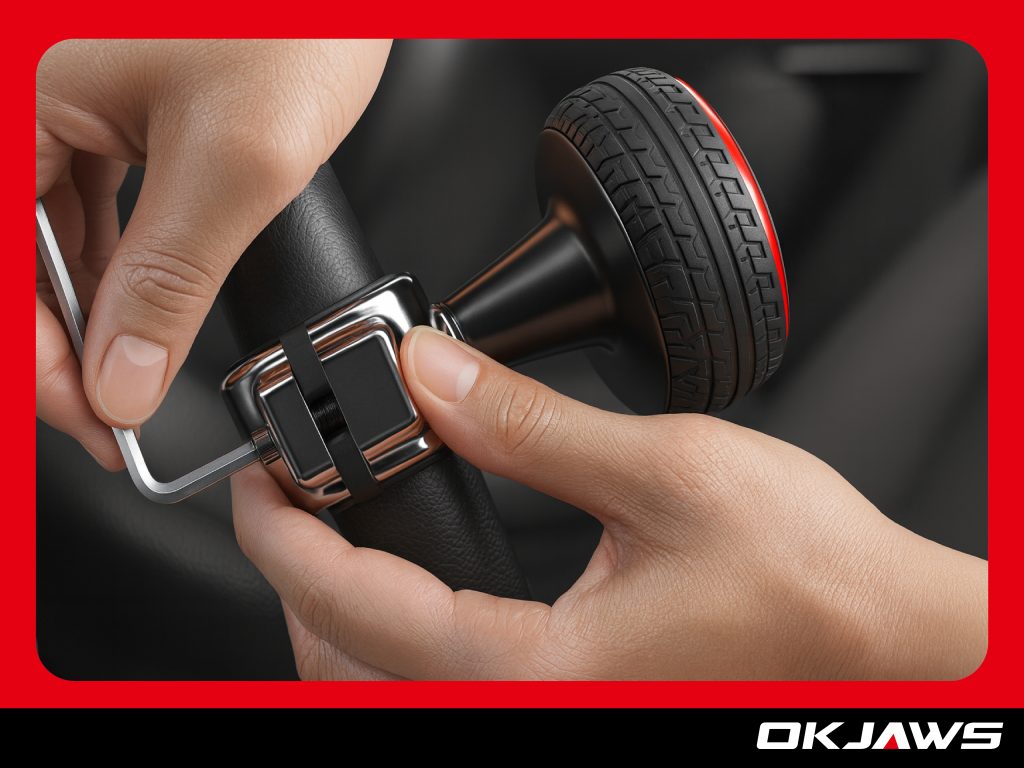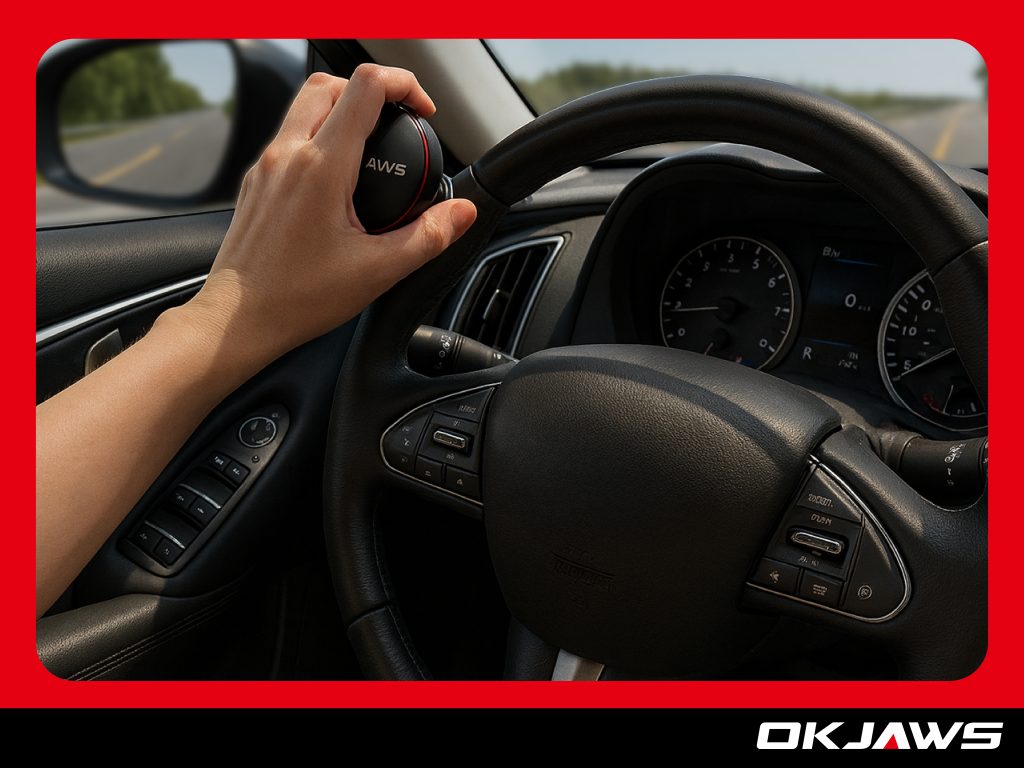Table of Contents
ToggleAbstract
- Introduction
- Steering knobs improve maneuverability and reduce steering effort.
- Correct selection impacts safety, comfort, and vehicle compatibility.
- Understanding Steering Knobs
- Definition: a device attached to the steering wheel for one-hand control.
- Types: ball-type, ergonomic grip, and bearing-equipped spinner knobs.
- Use cases: passenger cars, trucks, forklifts, and agricultural vehicles.
- Key Factors in Steering Knob Selection
- Vehicle compatibility: fit with cars, SUVs, trucks, forklifts; steering wheel size/material; compliance with OEM standards.
- Driver ergonomics: fatigue reduction, accessibility for disabled drivers, comfort and grip quality.
- Durability: zinc alloy vs. plastic bases, bearing quality, weather resistance.
- Vehicle Type and Recommended Knobs
- Passenger cars/SUVs: compact ergonomic knobs for comfort and style.
- Trucks/heavy-duty vehicles: reinforced knobs with anti-slip grips.
- Forklifts/agriculture: heavy-duty knobs with smooth bearings.
- Installation Guide
- Tools: Allen key, screwdriver, mounting kit.
- Steps: attach base, secure screws, adjust position, test functionality.
- Mistakes to avoid: over-tightening, wrong wheel size, blocking airbags.
- Maintenance and Safety Tips
- Regularly check knob tightness and bearing smoothness.
- Clean grip surfaces to maintain hygiene and friction.
- Replace knobs if cracked, noisy, or unstable.
- Compliance and Legal Considerations
- Regional rules: FMVSS (U.S.), ECE R (Europe), country-specific standards.
- Legal use: widely accepted for disabled drivers, restricted for general drivers in some areas.
- Certified manufacturers ensure compliance and reduce liability.
Introduction
A steering knob, often called a spinner knob or power handle, is a small but powerful accessory designed to improve vehicle maneuverability. By attaching directly to the steering wheel, it allows drivers to steer smoothly with one hand, reducing effort during sharp turns, parking, or low-speed maneuvering. Originally developed for industrial and agricultural vehicles, steering knobs are now widely adopted across passenger cars, trucks, and forklifts as reliable driving aids.
Choosing the right steering knob is not just about convenience—it directly impacts safety, comfort, and vehicle compatibility. An improper fit can cause discomfort, steering instability, or even violate local regulations. On the other hand, proper steering knob selection ensures ergonomic comfort, compliance with safety standards, and ease of installation. This makes it vital for both individual drivers and fleet managers to evaluate options carefully before purchase.
In this article, we’ll explore key factors in steering knob selection, how to assess vehicle compatibility, and provide a practical installation guide to help you choose confidently and drive safely.
Summary: Steering knobs enhance control and convenience, but correct selection is essential to ensure safety, comfort, and compatibility with your vehicle.
Understanding Steering Knobs
A steering wheel spinner is a compact device attached to a vehicle’s steering wheel, designed to make maneuvering easier, especially during frequent or sharp turns. By allowing drivers to operate the wheel with one hand, it reduces wrist strain and improves control in tight spaces. The purpose of a steering knob is not just convenience—it is also a practical solution for enhanced safety and driver efficiency in demanding driving conditions.
There are several common types of steering knobs available on the market:
- Ball-Type Knobs – Classic round design, simple and widely used, suitable for general driving.
- Ergonomic Grip Knobs – Shaped to fit the natural curve of the hand, offering improved comfort for long driving hours.
- Spinner Knobs with Bearings – Equipped with ball bearings for smoother rotation, reducing resistance and ensuring precise steering control.
Typical use cases vary by vehicle type and driving environment. Passenger car drivers may use knobs to assist with urban parking, while truck operators rely on them for better handling of large vehicles. Forklift and agricultural vehicle operators benefit most, as these knobs significantly reduce fatigue during repetitive low-speed maneuvers.
Summary: A steering knob is a practical device that enhances control and reduces effort. With different types such as ball-type, ergonomic, and bearing-equipped models, they are used across passenger cars, trucks, forklifts, and agricultural vehicles to improve comfort and efficiency.

Key Factors in Steering Knob Selection
Selecting the right steering spinner goes beyond aesthetics—it requires careful evaluation of compatibility, ergonomics, and material quality. Each factor plays a role in ensuring safety, comfort, and long-term reliability.
Vehicle Compatibility
Not every steering spinner suits every vehicle. Passenger cars and SUVs often require compact, ergonomic knobs that blend safety with style, while trucks and heavy-duty vehicles benefit from reinforced designs built for endurance. Forklifts and agricultural vehicles, which demand repetitive turning at low speeds, perform best with heavy-duty spinner knobs designed for continuous operation.
Equally important is the steering wheel size and material. Knobs must fit securely on wheels ranging from leather-wrapped car wheels to larger rubber-coated industrial wheels. In addition, compatibility with OEM steering systems and safety standards ensures both legal compliance and safe use.
Driver Needs and Ergonomics
Different drivers have different needs. For professional drivers, knobs reduce fatigue during long shifts, especially in logistics or heavy transport. Disabled drivers benefit from adaptive designs that make one-handed steering safe and practical, offering accessibility solutions recognized by mobility standards. For everyday users, ergonomic grips with soft-touch materials enhance comfort, while textured finishes improve grip and reduce slipping.
Durability and Materials
Material quality defines performance over time. Zinc alloy bases provide superior strength and durability compared to standard plastic bases, making them ideal for commercial or industrial vehicles. The bearing quality inside the knob is also crucial—high-grade bearings deliver smooth, noise-free rotation, while poor-quality bearings wear quickly. Finally, weather resistance matters: knobs exposed to sun, rain, or temperature fluctuations must maintain reliability without cracking, fading, or loosening.
Summary: Effective steering knob selection requires evaluating vehicle compatibility, driver ergonomics, and material durability. Choosing the right combination ensures safety, comfort, and reliable performance far beyond the product’s appearance.
Vehicle Type and Recommended Knobs
The right steering knob depends largely on the type of vehicle and its primary usage. Each category of vehicle has unique demands, and selecting the appropriate knob ensures comfort, compliance, and performance.
Passenger Cars and SUVs
For passenger cars and SUVs, priorities include comfort, style, and safety compliance. Drivers in this segment often seek knobs that are discreet yet functional, blending seamlessly with the interior design while complying with local regulations. Compact ergonomic knobs with soft-touch grips are recommended, as they provide smooth steering assistance without compromising vehicle aesthetics.
Trucks and Heavy-Duty Vehicles
Truck drivers and operators of other heavy-duty vehicles prioritize durability and fatigue reduction. Long hours on the road or managing large vehicles demand a knob that can withstand continuous stress while reducing strain on the wrists. The best choice is a reinforced base knob with an anti-slip grip, built from durable materials like zinc alloy, designed to endure constant use in demanding environments.
Forklifts and Agricultural Vehicles
Forklifts, tractors, and other agricultural machinery require precise low-speed control and heavy-use durability. These vehicles often operate in confined spaces or on uneven terrain, where quick maneuvering is essential. The ideal solution is a heavy-duty spinner knob equipped with high-quality bearings, which provides smooth, reliable rotation even under repetitive, high-intensity usage.
Summary: Different vehicle types demand different knob designs. Passenger cars and SUVs benefit from compact ergonomic models, trucks require reinforced anti-slip knobs, and forklifts/agricultural vehicles perform best with heavy-duty knobs featuring smooth bearings.
Installation Guide
Installing a steering knob is a straightforward process, but attention to detail is essential to ensure both safety and performance. With the right tools and proper preparation, most drivers can complete the installation in under 15 minutes.
Tools and Preparation
Before starting, gather the basic tools: an Allen key, screwdriver, and the provided mounting kit. Make sure the steering wheel surface is clean and dry, as dirt or moisture can reduce grip. Take safety precautions by parking the vehicle on level ground, turning off the ignition, and engaging the parking brake to prevent unintended movement.
Step-by-Step Installation
- Attach the base – Position the knob base on the steering wheel, ensuring it fits the curvature securely.
- Secure with screws – Tighten the screws evenly with the Allen key or screwdriver, avoiding excessive force that could damage the wheel surface.
- Adjust knob position – Place the knob at a comfortable location (usually around the 10 o’clock or 2 o’clock position) for easy reach.
- Check functionality – Rotate the knob to confirm smooth spinning and verify that the grip does not loosen under pressure.
Common Mistakes to Avoid
- Over-tightening screws – This can damage the steering wheel material or crack the knob base.
- Installing on incompatible wheel sizes – A poor fit can lead to instability or unsafe operation.
- Blocking airbags or obstructing controls – Always check that the knob placement does not interfere with safety systems or dashboard functions.
Summary: With the proper tools and preparation, installing a steering knob is simple. By following step-by-step instructions and avoiding common mistakes, drivers can ensure a safe and secure fit.

Maintenance and Safety Tips
A steering knob requires periodic care to ensure consistent performance and safety. Regular maintenance not only extends the product’s lifespan but also safeguards the driver by preventing unexpected malfunctions.
- Check tightness and bearing smoothness regularly – Inspect the screws and mounting base every few weeks to ensure the knob remains securely fastened. Rotate the knob to confirm that the bearings spin smoothly without resistance or noise.
- Clean the grip surface – Over time, dirt, sweat, and oils can build up, reducing friction and hygiene. Wipe the knob with a damp cloth or mild cleaner to maintain a firm, slip-free grip.
- Replace when necessary – Any signs of cracks, wobbling, or unusual noises are indicators that the knob should be replaced. Continuing to use a damaged knob can compromise steering control and safety.
Summary: By checking tightness, keeping the grip clean, and replacing damaged knobs promptly, drivers can maintain safe, reliable steering knob performance over the long term.
Compliance and Legal Considerations
When choosing and installing a steering knob, it is important to understand the legal frameworks that apply in different markets. Regulations vary widely across regions, making compliance a critical factor for both individual users and fleet operators.
- Regional Rules – In the United States, the Federal Motor Vehicle Safety Standards (FMVSS) provide guidelines on vehicle modifications, while some states impose additional restrictions on steering aids. In Europe, the ECE R regulations govern safety requirements, ensuring that steering knobs meet standardized testing criteria before being approved for use. Other regions, such as Japan and ASEAN markets, may also have country-specific rules that align with or differ from global standards.
- Disabled Drivers vs. General Drivers – In many jurisdictions, steering knobs are legally permitted as adaptive devices for disabled drivers. They are often prescribed as part of mobility aids to enhance accessibility. However, for general drivers, regulations may be stricter, sometimes requiring proof of necessity or limiting use to certain vehicle categories such as forklifts or agricultural machinery.
- Certified Manufacturers – Sourcing from certified manufacturers is crucial to avoid legal and safety risks. Certified suppliers ensure compliance with international standards, provide documentation for fleet buyers, and reduce liability in the event of an accident. Choosing a low-quality or uncertified knob can expose drivers and companies to regulatory violations and safety hazards.
Summary: Legal compliance depends on regional regulations, driver eligibility, and product certification. By sourcing from certified manufacturers, buyers ensure both regulatory alignment and long-term safety.

Conclusion & Call to Action
Choosing the right steering knob is more than a matter of convenience—it directly affects safety, vehicle compatibility, and driver comfort. By considering factors such as knob type, vehicle category, ergonomic design, and material durability, drivers can ensure reliable performance and a more comfortable driving experience.
To guarantee compliance and safety, it is always recommended to consult certified manufacturers or trusted distributors before making a purchase. Working with professionals helps avoid compatibility issues, ensures adherence to regional regulations, and provides peace of mind that the product meets international standards.
For B2B buyers, distributors, and fleet managers, OKJAWS deliver professional-grade steering knobs backed by decades of manufacturing expertise. With a reputation for quality, innovation, and compliance, our solutions are designed to meet the needs of both individual drivers and large-scale procurement.
Summary: Correct steering knob selection ensures safety, comfort, and compliance. By choosing certified products from trusted manufacturers like OKJAWS, buyers secure reliable solutions for long-term use.

